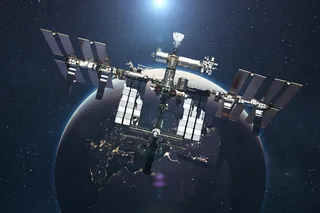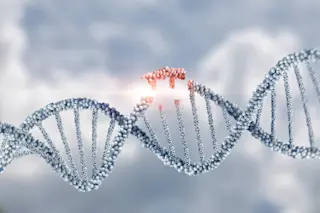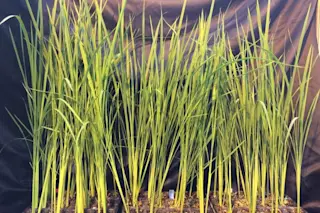For four years, the state of California has experienced a devastating drought. It's not just a little dry—according to scientists, it's the worst drought in over a millennium, fueled by global climate change. Cali is in such dire straits that Governor Edmund G. Brown Jr. just signed two emergency measures to funnel another $1 billion to drought relief and critical water infrastructure projects. No sector is feeling the hit more than Golden State's agricultural industry, where the shortage of water has already cost farmers billions. And California's drought is just the beginning; scientists predict severe and widespread droughts globally in the next 30 to 90 years. Given that the world's farmers account for 75% of our freshwater use, these droughts will cause massive losses in crop production unless the agricultural industry as a whole can find a way to maintain production with less water input. It's a puzzle that genetic engineers are eager to solve. Drought-resistance has been one of the top priorities for genetic engineers, but for decades, frustratingly few viable products have emerged. Monanto's DroughtGard corn is the only commercially available GM designed to withstand dwindling water supplies, and it has only just been released. Now, scientists are unlocking the secrets of efficient water use in plants' genomes. “We now have genetic tools to pre-adapt crops to future, drier climates,” said Peter Franks, Faculty of Agriculture and Environment at the University of Sydney and lead author of a study released this month in New Phytologist. "The goal here is to maintain or improve productivity with less water." And improve it they have. Their recent paper details how the overexpression of one gene — epidermal patterning factor 2 (EPF2) — gave Arabidopsis thalania plants (a kind of mustard green) an edge in drier environments.
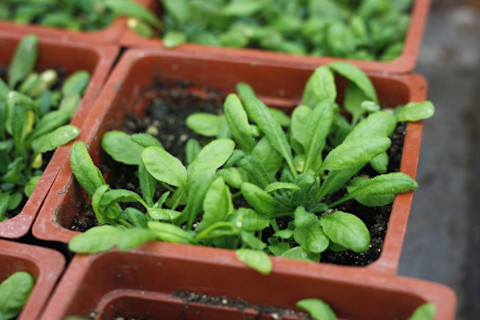
The mustard green Arabidopsis thaliana is a model organism, and now, scientists have made a drought-resistant version by changing the regulation of one gene. Photo via Wikipedia EPF2 encodes for a small peptide which helps regulate the number of stomata, tiny pores in leaves which allow for gas exchange. These little holes also allow water vapor to escape, and thus plants with more stomata tend to use more water while those with fewer are more efficient. By manipulating the expression of EPF2 genetically, the team was able to create a modified plant with fewer stomata per leaf which, as expected, used less water. But most importantly, their new variety was able to use less water without sacrificing the plant's photosynthetic ability or reproduction, especially in a high carbon dioxide atmosphere. In other words, they created a mustard green that will thrive in our dry, CO2-filled future. Much of the current criticism of GMOs rests on the currently-available varieties, dominated by RoundUp Ready (herbicide-resistant) and Bt (pesticide-producing) varieties. But these crops are hardly good measures of the potential for genetic technologies. Even within the current GM categories, scientists are making advances that result in more even environmentally-friendly products. For example, scientists from the Max-Planck Institute in Germany reported a novel anti-pest potato plant in Science last month. This new GMO is able to fight off the Colorado potato beetle, a beast referred to as an “international superpest” because it has evolved resistance to all major insecticide classes over the past century. But it doesn't kill by producing a general pesticide like Bt crops; instead, it produces very special insecticidal RNAs which kill only the potato beetles and nothing else. The plant kills its pest by taking advantage of RNA interference (RNAi), which is an innate genetic mechanism to suppress gene expression found in many species. Double-stranded RNA in cells is cut by an enzyme called Dicer into small chunks about 21 nucleotides long, referred to as short interfering RNAs (siRNAs). These siRNAs bind to any RNA molecules with complementary chunks, essentially placing a target on the RNA molecule. A set of cellular components referred to as RNA-induced silencing complex then zero in on these RNA molecules and destroy them. Geneticists outside the agricultural industry have been using RNAi for years now to produce varieties of organisms that lack certain genes to model certain diseases or uncover the uses for certain proteins. Now, agricultural scientists are learning how to get plants to produce dsRNAs that are harmless to them but deadly to pests that eat their leaves. The German team created potato plants that produce dsRNAs designed to target two genes in the beetle that are absolutely essential for survival (β-actin and Shrub). It's not the first transgenic plant to use RNAi as a pest control mechanism, but it's the first to produce the insecticidal RNAs in the chloroplasts instead of the main cells, thus avoiding the plant's own RNA chopping Dicer. By moving the inserted genes to the chloroplasts, the team was able to kill potato beetles with unmatched efficiency.
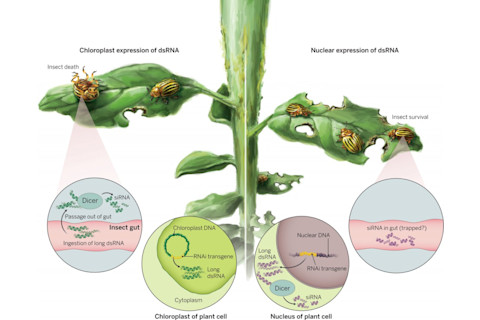
A brief explanation of how moving the genes into chloroplasts leads to more effective insecticidal RNAi. Illustration from Whynard 2015. "Shifting the target of transgenesis from the nucleus to the plastid removes the major hurdle on the way to exploiting transgenically delivered RNAi for efficient plant protection in the field," explain the authors in their conclusions. But the best part is that insecticidal RNAs are specific to the species targeted and are not proteins, thus are not allergenic to people. "The dsRNA approach provides plant protection without chemicals and without synthesis of foreign proteins in the plant." That last part is especially important given that public support of GMOs is currently abysmal, as many harbor unsubstantiated fears that genetic manipulation will have dire, unforeseen consequences. To succeed, the GMOs of tomorrow must find a way to alleviate such fears. These two recent studies represent just a tiny subset of the diversity of issues genetic engineers hope to use biotechnology solve. In addition to drought and pests, crops are being designed to fightmalnutrition and produce vaccines. There's no doubt that the next generation of GM crops will look very little like the oft-maligned varieties available today. The possibilities are nearly limitless, as are the rewards. And with the world's climate changing rapidly, there's no doubt that agriculture will need to change with it, to keep pace with an unpredictable environment. The future of agriculture may very well depend on the ingenuity of geneticists and the GMOs they create. The real question is, will these new varieties be able to do what current ones cannot: win over the hearts and minds of the people they're designed for. Citations:
Franks P.J., Tim Doheny-Adams, Zoe J. Britton-Harper & Julie E. Gray (2015). Increasing water-use efficiency directly through genetic manipulation of stomatal density, New Phytologist. DOI: http://dx.doi.org/10.1111/nph.13347
Zhang J., C. Hasse, S. Ruf, D. G. Heckel & R. Bock (2015). Full crop protection from an insect pest by expression of long double-stranded RNAs in plastids, Science, 347: 991-994. DOI: http://dx.doi.org/10.1126/science.1261680



